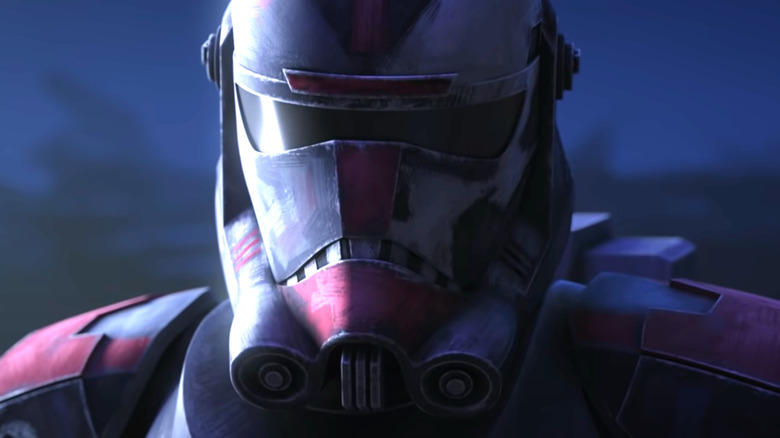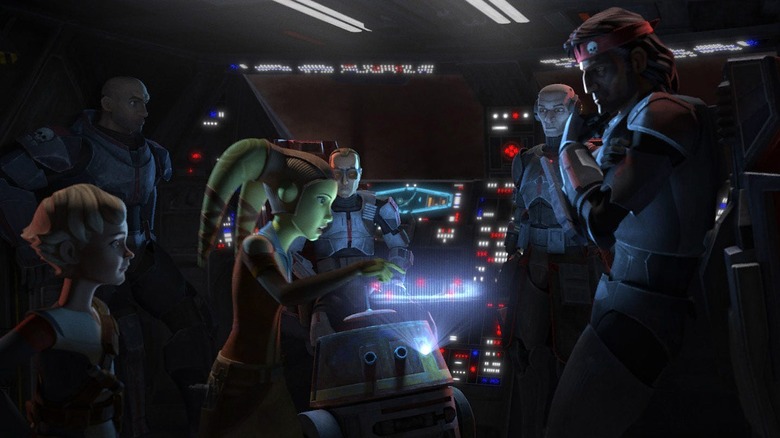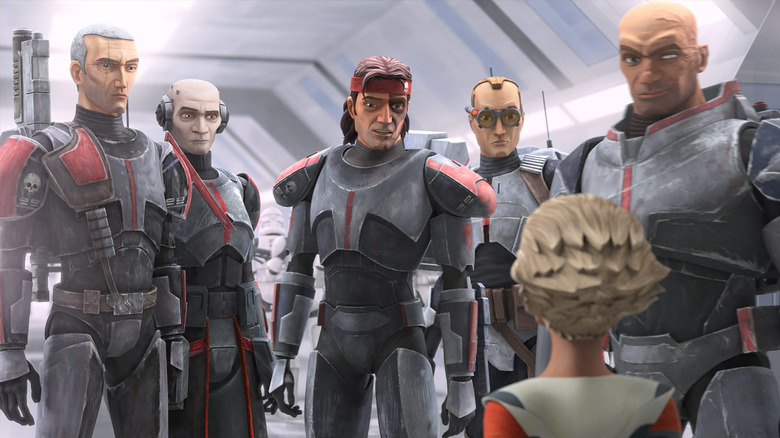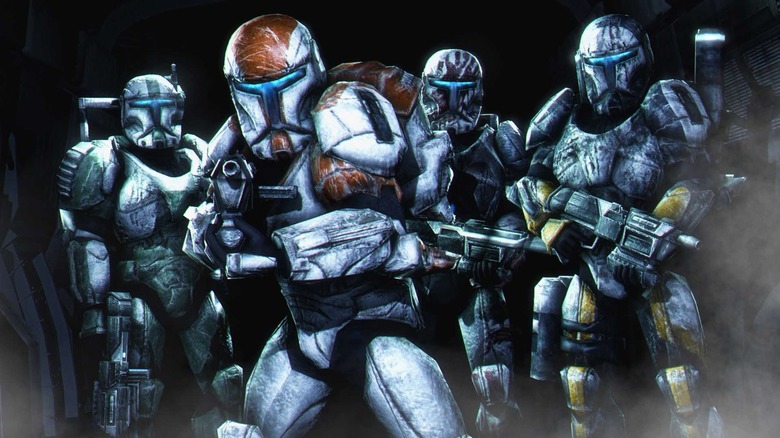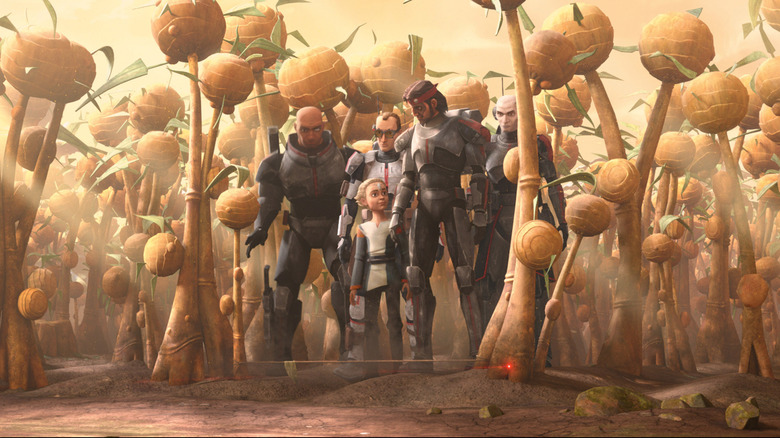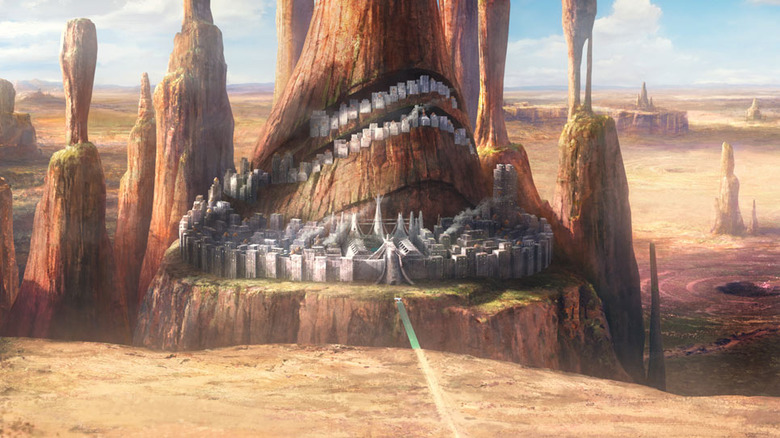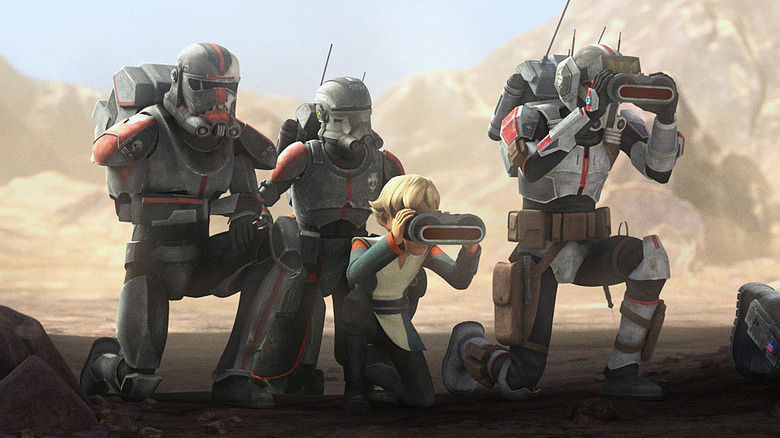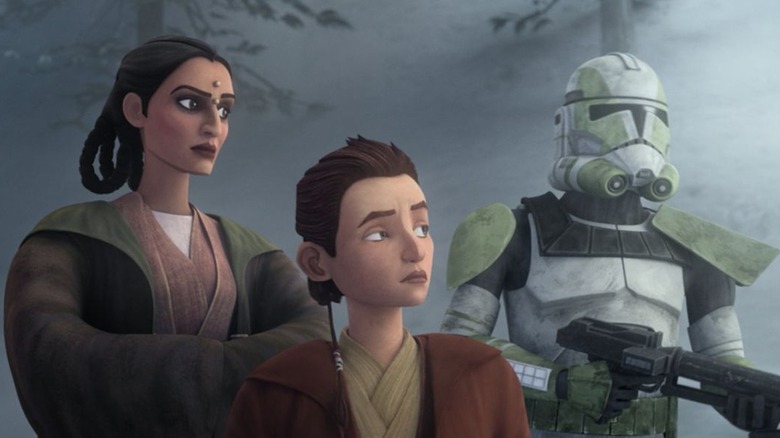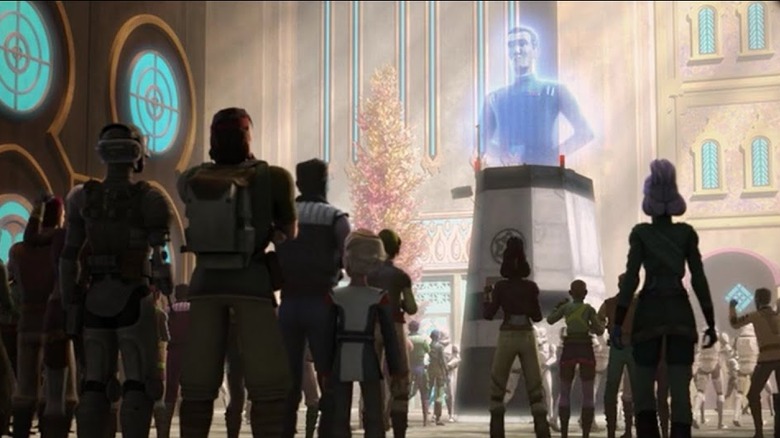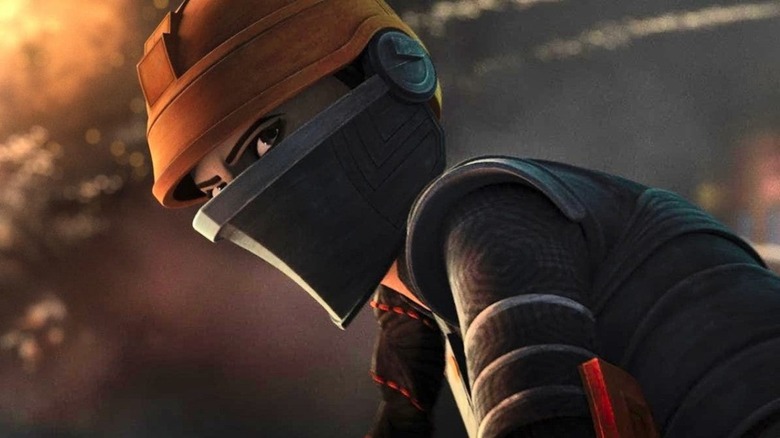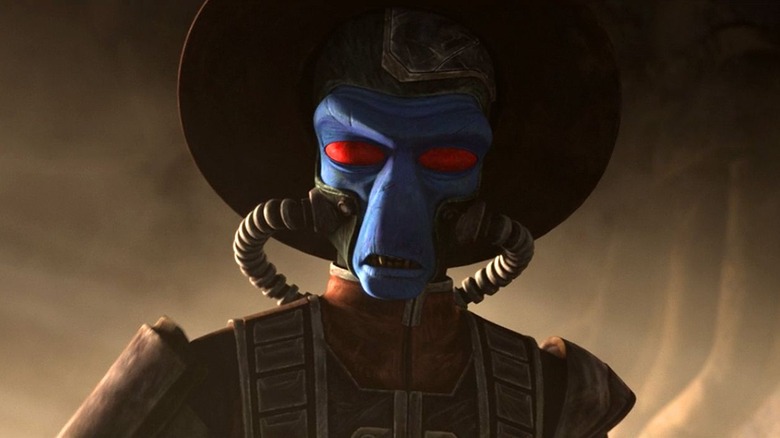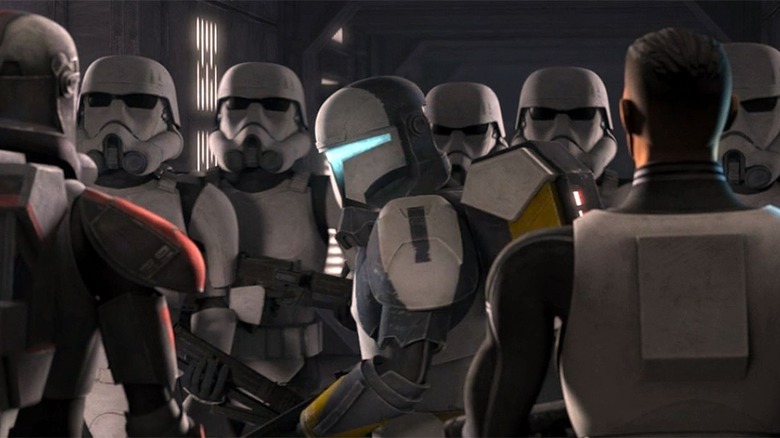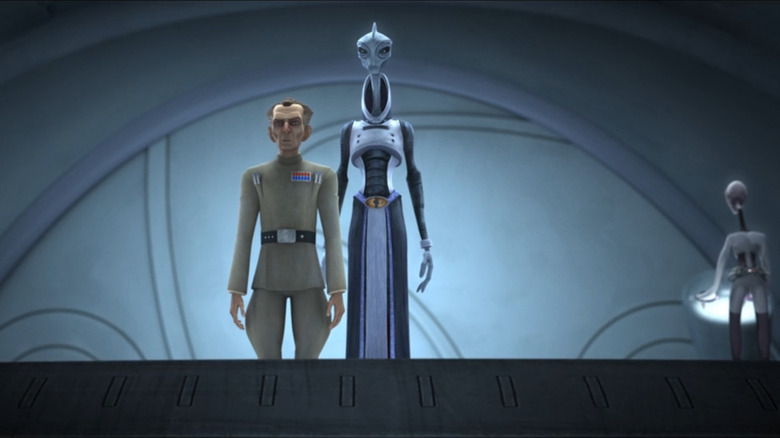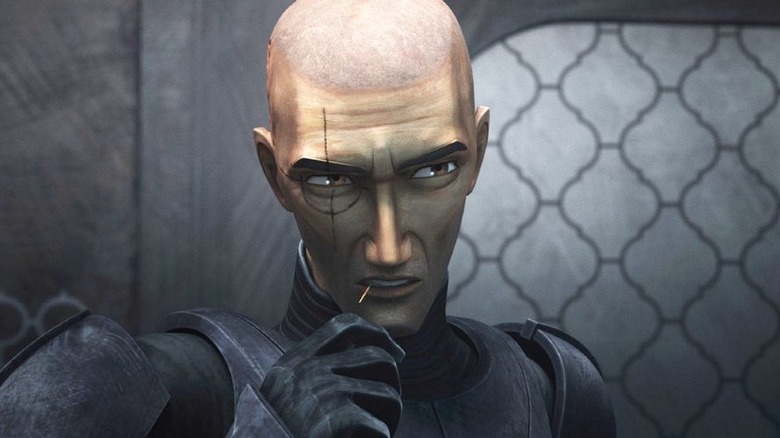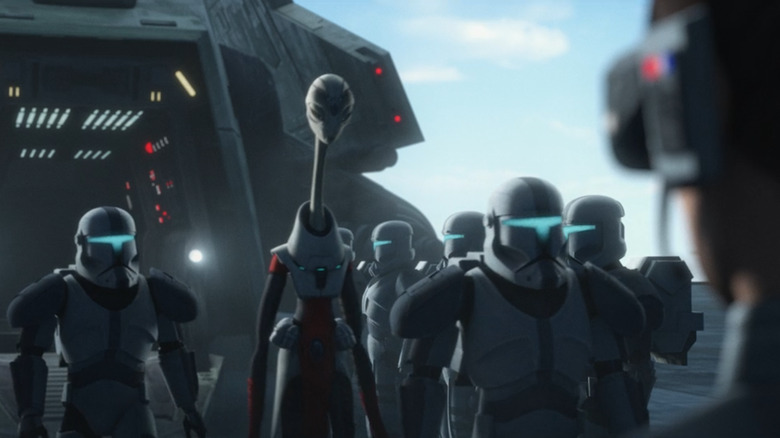Things Only Adults Notice In Star Wars: The Bad Batch
When "Star Wars: The Bad Batch" was originally announced, many fans weren't sure what to make of it, but after finally getting a chance to watch it on Disney+, viewers around the world are already debating their favorite member of the squad. Though opinions on the show have been mixed, it's earned its spot in the "Star Wars" canon and is quite clearly here to stay.
Introduced in the first story arc of the final season of "Star Wars: The Clone Wars," the veteran commandos of Clone Force 99 were one of the most elite fighting units in the Clone Army, but when the Old Republic is transformed into the First Galactic Empire by Darth Sidious, the titular Bad Batch are forced to find their way in a galaxy they no longer understand. The show is one of the first projects to explore the first days of Palpatine's Empire onscreen, and its place in that transitionary period has provided longtime fans a unique look at what was previously one of the most obscure time periods in the "Star Wars" timeline.
The show is both a sequel and a prequel
The show's first teaser clearly established "The Bad Batch" as a sequel to "The Clone Wars." It used the same advanced animation and art style as "The Clone Wars" Season 7, and its first episode opened with "The Clone Wars" classic narration and logo before literally burning away to reveal the new logo of "The Bad Batch." It sent a very clear message: the Clone Wars are over, and this is what comes next.
The use of Echo, Cad Bane, Captain Rex, the Martez Sisters, and many other characters from "The Clone Wars" across the first season of "The Bad Batch" cements this notion, but that feeling begins to shift when Ming-Na Wen's Fennec Shand from "The Mandalorian" makes her animated debut in Episode 4, "Cornered," and when Hera and Chopper from "Star Wars: Rebels" unexpectedly appear in Episode 11, "Devil's Deal," it quickly becomes clear that the show isn't just a sequel. It's a prequel as well.
Caleb Dume, who would later go by the name "Kanan Jarrus" in "Rebels," appears in the first episode. Episode 5 explains how Jabba the Hutt acquired the Rancor beast that Luke kills in "Return of the Jedi," and Episode 14, "War-Mantle," reveals the first generation of Imperial stormtroopers and begins the transition away from the Clone Army in earnest.
The Bad Batch are all action movie archetypes
After finishing their introductory arc in "The Clone Wars" Season 7, many fans were rather nonplussed by the fact that each member of the Bad Batch was an action movie archetype. Wrecker is the classic dumb, loudmouthed strongman. Crosshair is the quiet, rude, stone-faced sniper, and Tech is, well, their tech support. Add this to the fact that Hunter's design is quite clearly meant to be the "Star Wars" version of Rambo, and many fans were wondering if the franchise really needed its own version of the A-Team or the Expendables.
When the show finally began streaming, however, Clone Force 99 quickly made it clear that, yes, yes it did. With more screen time, each member of the squad was able to become more than the stereotype they were clearly based on, and as those individualities were more firmly established, it became easier to enjoy the show's many action movie sensibilities.
The Bad Batch are Republic Commandos
Each original member of "The Bad Batch" serves a clearly defined role in the squad. Hunter is the well-rounded leader and tracker, Crosshair is the sniper, Wrecker is the demolitions expert, and Tech is, obviously, their go-to guy for anything to do with technology. Each member's specialties were purposefully enhanced by the Kaminoans as a special experiment, but longtime fans of "Star Wars" video games will easily recognize exactly what the Bad Batch were altered from: Clone Commandos.
One of many pieces of "Star Wars" media released in 2005, "Star Wars: Republic Commando" was a highly anticipated first-person shooter video game that introduced fans to the Clone Army's commando squads, which were always teams of four who were especially tailored to fill specific roles in the squad. The leader would be a jack of all trades while his three teammates would specialize in sniping, demolitions, and tech support.
The original four members of Clone Force 99 very clearly fill the same roles, and if the connection wasn't clear enough, Wrecker and Hunter both clearly sport modified versions of the commando's "Katarn-class" armor and are often seen using the game's signature DC-17m blaster rifles. Additionally, when the camera shows Hunter's point of view after being shot by Cad Bane, it uses the exact same heads-up-display as the helmets from the video game, even going so far as to utilize the same sound effects and crosshair symbol.
The show continues Star Wars' long-running exploration of fatherhood
One of the "Star Wars" franchise's most important themes is fatherhood. The original trilogy revolves around the relationship between Luke Skywalker and his father, Darth Vader. In the prequels, Anakin is identified as the Chosen One because he has no father, and losing his chance at finding a father figure in Qui-Gon Jinn ultimately decides his fate. In the sequels, Kylo Ren's relationship with his father Han Solo serves as the crux of his transitions both to and from the Dark Side, and Rey's search for her parents is one of her primary motivations in every film.
"The Bad Batch" continues this theme in a manner similar to "The Mandalorian" by having the squad's grizzled soldiers unexpectedly need to care for a gifted child. Just like Pedro Pascal's Din Djarin has to figure out how to care for Grogu, the Bad Batch have to learn how to raise Omega, a small girl who was also somehow cloned from Jango Fett just as they were.
Though technically variants of the same person, Omega learns from each of her "brothers" as the squad's leader, Hunter, becomes her father figure and does his best to simultaneously set a good example for her, train her, and keep her safe while performing mercenary work throughout the galaxy to keep them all fed. Parenthood is never easy, and in the "Star Wars" universe, it often involves an unfortunate amount of blaster fire.
The show's protagonist isn't the Batch; it's the universe
Despite the show's name, the main protagonist of "The Bad Batch" isn't the squad themselves, but the Star Wars universe as a whole. Many modern television series have through lines connecting episodes across each season that typically involve a "big bad" whom the heroes defeat in the finale. In "The Bad Batch," however, that through line is the transition from the Old Republic to Palpatine's new Empire.
Just as the "Clone Wars" logo literally burns away to make room for something new, so too does the Old Republic burn down after Order 66 to become the Empire, and nearly every episode of the show takes time to explore exactly how the galaxy changes as a result. Fans watch as the clones become near-mindless drones after Order 66, and as the Empire establishes fascist strangleholds on planets across the galaxy regardless of whether its peoples were allies or enemies during the war.
The most important transition in the show, however, is the Empire choosing to discard the Clone Army in favor of conscripted Imperial stormtroopers. The topic is established in the very first episode, and Episode 3, "Replacements," introduces the Empire's plan to have the clones train their eventual replacements. Episode 14, "War Mantle," reveals the first results of that plan, and after Kamino's clone facilities are completely emptied and destroyed by the Empire in the show's two-part finale, that specific transition is finally completed, and the season ends.
Omega is constantly copying her brothers
Though "The Bad Batch" has its shortcomings, one of its greatest achievements is establishing a child character who is simultaneously endearing, believable, and most importantly, not annoying. Children in fiction are notoriously difficult to write well and are infamous for becoming annoying hindrances to the plot that viewers are desperate to be rid of, but like "The Mandalorian" before it, "The Bad Batch" manages to make its young character, Omega, a fan favorite.
From her profound wonder at seeing dirt for the first time after leaving Kamino to her earnest and sincere efforts to belong as a true member of the squad, Omega is one of the most believable child characters in the franchise. This helps sell the show's themes of parenthood, and one of the most effective ways the creators manage this is Omega's very realistic tendency to mimic and copy everything the Bad Batch does.
Every parent and childcare worker knows that children often copy adults, and Omega is no exception. In the show's first episode, she mirrors the way Hunter sits in the Kaminoan holding cell and mimics his mannerisms as they escape and sneak through the facility. In the third episode, she follows along as Hunter shifts dirt while tracking a wild animal, and in the fifth episode, she copies Tech and Wrecker as they examine an enemy camp using binoculars. Omega consistently copies her brothers throughout the show, and that's one of its best creative choices.
The show's premiere rewrote Star Wars canon ... again.
Many adult "Star Wars" fans have experienced their fair share of retcons during their long fandom, and viewers of "The Bad Batch" witnessed yet another one in the opening minutes of the show's first episode, "Aftermath," when Jedi Master Depa Billaba and Padawan Caleb Dume are rescued by the Batch on the planet Kaller shortly before the execution of Order 66. Caleb Dume is the childhood name of Kanan Jarrus, one of the main characters from "Star Wars: Rebels," and though its fans loved seeing more of his backstory, it came at a cost.
The death of Kanan's master at the hands of the clones forms a major part of Kanan's backstory in "Rebels," and though it's rewarding to see that onscreen, the event had already been shown in the comic book series "Star Wars: Kanan," and it is drastically different. In the show, Order 66 is issued during the daytime after the arrival of the Bad Batch. In the comic, however, the Bad Batch is nowhere to be found, and the order is issued at night while the Jedi sleep.
Because of discrepancies like this, that comic book's entire story may no longer be canon, and an incredibly emotional story may no longer "exist" in the "Star Wars" universe. This is an incredibly steep and unfortunate price to pay for a call-back that only lasts a few minutes.
The Empire executes some brilliant economic world-building
In the second episode, "Cut and Run," the Bad Batch have to forge fake identities using the Empire's new "chain codes." First introduced in "The Mandalorian," chain codes are basically IDs that also function as the "Star Wars" version of passports and Social Security cards. With them in place, the Empire will know who everybody is and be able to track them wherever they go. They also come with a fascinating monetary incentive: every citizen with a registered chain code can exchange their "invalid currency" for Imperial Credits for "free."
This is one of the most brilliant pieces of world-building in all of "Star Wars." With one line, the Empire's complex economic agenda is laid bare. Every economy depends on accepted forms of currency to function, and as a new government, establishing their currency as the only official form of money is vital to the Empire's long-term survival.
Controlling the currency helps them control the economy, but they can't do that unless their form of money, Imperial Credits, holds value, and that won't happen unless they are both used and backed by some tradable commodity. By "generously allowing" Imperial citizens to exchange their currency in exchange for Imperial credits, the Empire is simultaneously backing their currency and ensuring its use at the same time with the same action, granting it value in one fell swoop.
Fennec Shand is a great example of a competent and well-written female villain
Ming-Na Wen's character, Fennec Shand, quickly became a new fan favorite after her debut in "The Mandalorian," inspiring Dave Filoni to bring her back in "The Bad Batch" Episode 4, "Cornered," which showed exactly how to portray a competent and well-written female villain. Throughout the episode, Fennec is, above all else, intelligent and pragmatic.
Because her job is to capture Omega alive, she coaches her throughout the episode to make sure she survives long enough to be successfully kidnapped. Though it nearly seems like she cares about her, Fennec is clearly only doing it to serve herself. Similarly, she isn't crazed or sadistic, but she doesn't hesitate to murder those who stand in her way. She only does this if absolutely necessary, but that's not because of some moral code or because she's a good but misguided person. It's simply a matter of practicality. Killing indiscriminately is a waste of time and ammo and brings unwanted attention.
Fans see Fennec's pragmatism once again when her contact fails to keep the Batch from leaving. While many "Star Wars" villains would've killed him for his failure, she simply pays him like she agreed to. It's far more practical to honor her agreement, build her credibility, and gain a useful contact for the future than it is to indulge in wanton bloodlust, and unlike Asajj Ventress in the early seasons of "The Clone Wars," she is never sexualized or objectified.
Cad Bane's appearance confirms the events of a cancelled Clone Wars story
One of the best episodes of "The Bad Batch," "Reunion," ends with the sudden and surprising reappearance of "Clone Wars" bounty hunter Cad Bane. A fan favorite, many believed that Bane had likely died in a canceled "Clone Wars" story arc that would have climaxed with a duel between Bane and Boba Fett himself. Though many details about the proposed story are unclear, the final duel would have seen Bane and Boba shoot each other in the head, seemingly killing Bane and giving Fett the classic dent in his helmet.
Though Bane's appearance in "Reunion" seemed to cast doubt on that theory, the very next episode, "Bounty Lost," all but confirmed that the story had already happened when Bane's hat was removed, and fans could clearly see a new metal plate covering a part of his skull. The bounty hunter's character model in "The Clone Wars" didn't have this feature, and its sudden addition is almost certainly the result of whatever life-saving surgery was used to save him after he was shot in the head.
The squad nearly got Scorched by an old Legends character
In Episode 14, "War-Mantle," the Bad Batch attempt to rescue a Clone deserter named Gregor from a secret Imperial base inside a mountain. Once they breach the facility, the squad discovers that Clone Commandos have been training the Empire's new stormtroopers. Including clone commandos in the show is quite fitting given the Batch's unique origins, but what makes their appearance even better is the identity of the Clone Commando that tries to halt their escape: CC-1262, aka Scorch.
Voiced by Raphael Sbarge in the "Star Wars: Republic Commando" video game, Scorch was one of the first Clone Commandos introduced in the "Star Wars" universe. Longtime fans fought alongside Scorch and the rest of Delta Squad throughout "Republic Commando," and getting to see him again as an Imperial Commando in "The Bad Batch" was likely as exhilarating as it was horrifying. The fan favorite character was back, but he was also a slave of the Empire who might very well die at the hands of the Batch or kill one of them himself.
Thankfully, fans of the commando could rest easy, as not only does Scorch survive the encounter, he nearly incapacitates the entire Bad Batch by himself while he does it, and everybody lives to fight another day. Though there's no way of knowing if this was a one-time cameo or a hint of things to come, Scorch's appearance made many fans giddy with glee.
Kamino was their home
In the first part of "The Bad Batch" season finale, "Return to Kamino," Imperial Admiral Rampart orders his three Venator Star Destroyers to fire upon and destroy the cloning facilities of Kamino. As the literal birthplace for every clone in the Republic Army, Kamino was the closest thing they had to a home, and this is exactly how the clone soldiers referred to it when they defended it from a droid invasion in "Star Wars: The Clone Wars" Season 3, Episode 2, "ARC Troopers."
This tangible and long-lasting connection to the planet makes the city's destruction particularly emotional for "Clone Wars" fans, but what many viewers may not have noticed is the incredibly dark and twisted fact that Admiral Rampart gave the order to destroy the facility to a clone officer on his bridge. Because of the brain-controlling nature of Order 66, the clone troopers enslaved by the Empire were literally forced to destroy their own home world.
This horrifying fact was further reinforced in the second part of the finale, "Kamino Lost," when fans watched as a clearly distraught Clone Army officer reports to Admiral Rampart that the city has been completely destroyed.
Crosshair's chip might not actually be gone
In order to control the clones, "inhibitor chips" were installed in all of them, and when Order 66 was issued, those chips were pushed into overdrive, turning the once-loyal soldiers into nearly mindless killing machines. Because of Clone Force 99's radically different genetics, their inhibitor chips failed with one exception: Crosshair.
His partially activated, and when he returned to Kamino, Grand Moff Tarkin forced the Kaminoans to fully activate it, making Crosshair turn on his brothers and betray them in favor of the new Empire. Fans wondered throughout the season what would happen when Crosshair's chip was finally removed, but "Return to Kamino" answered that question with an unexpected twist: Crosshair's inhibitor chip had already been removed, and he was still loyal to the Empire.
Unless it wasn't removed, of course. Throughout the series, a clone groaning and holding his head as if he had a headache was established as a sign that a clone was fighting his inhibitor chip. Crosshair does it throughout the first episode until Tarkin fully activates his chip, and Wrecker does the same thing until his chip is removed in "Battle Scars." Despite the fact that Crosshair's chip is supposedly gone, Crosshair continues to hold his head in pain in this exact same way in both "Return to Kamino" and "Kamino Lost." He may claim his chip is gone, but he certainly isn't acting like it.
The season finale ties in to The Mandalorian
The first season of "The Bad Batch" ends with the destruction of Kamino at the hands of the Empire, but before they destroy the planet's cloning facilities, the Empire makes a point of moving the planet's cloning scientists to a secure location. The Emperor has plans for the cloners, and they will serve him alone.
The final scene of the season shows lead clone scientist Nala Se arriving at an Imperial facility where she is greeted by an unnamed scientist in a special uniform that fans have seen before in "The Mandalorian." The live-action version of the uniform was worn by Doctor Pershing, an Imperial scientist who studied Grogu on behalf of Moff Gideon.
Though a minor character in the show, he sparked a mountain of speculation when fans realized that the patch on his uniform was a symbol they had only seen before on Kamino, seemingly confirming that he was some form of Imperial cloning scientist. The appearance of another scientist in "The Bad Batch" almost certainly confirms this idea and unexpectedly ties the animated series into the live-action story being told across several shows on Disney+.
